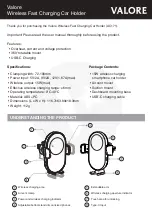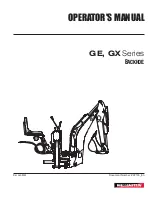
are third-level keywords, and so on. A colon (:) always separates a
command keyword from a lower-level keyword as shown below.
ARM:LAY2:SOUR EXT
A semicolon (;) is used to separate two commands within the same subsystem,
and can also save typing. For example, sending this command message:
ARM:LAY2:SOUR EXT;SLOP POS;COUN 10
Is the same as sending these three commands:
ARM:LAY2:SOUR EXT
ARM:LAY2:SLOP POS
ARM:LAY2:COUN 10
Manual Format
The typical format of commands listed in the command reference and
throughout this manual is:
[SOURce:]FREQuency[1]:MODE <
mode
>
Command headers enclosed in square brackets ([ ]) are optional. Upper-case
letters in the header are required, lower-case letters can be omitted.
Note
The brackets are not part of the command and are not sent to the
instrument.
To aid in learning the AFG command set, all headers are included in the
example programs; however, the headers are abbreviated. In an example
program, the previous statement with a
<
mode
>
parameter of
FIX
would appear
as:
SOUR:FREQ1:MODE FIX
Command Coupling
Many of the AFG SCPI commands are value coupled. This means that the
value set by one command may affect the valid limits for the values of other
commands. This can result in "Settings Conflict" errors when the program
executes. To prevent these errors, the AFG commands must be executed in
"Coupling Groups". The coupling groups are frequency and voltage. Some
commands (like
[SOURce:]FUNCtion[:SHAPe]
) are associated with both
groups. These commands are a bridge, linking (coupling) the two groups.
Commands not in a coupling group must precede or follow commands in
the coupling groups. Executing uncoupled commands in a coupling group
breaks the coupling and can cause a "Settings Conflict" error.
The coupling groups and associated commands can be found in Table B-2 in
Appendix B.
Chapter 1
Getting Started 27
Summary of Contents for E1445A
Page 2: ......
Page 14: ...Notes 12 Agilent E1445A User s Manual Contents...
Page 18: ...Notes 16 Agilent E1445A Arbitrary Function Generator User s Manual...
Page 19: ...Notes Agilent E1445A Arbitrary Function Generator User s Manual 17...
Page 20: ...Notes 18 Agilent E1445A Arbitrary Function Generator User s Manual...
Page 54: ...Notes 52 Getting Started Chapter 1...
Page 84: ...Notes 82 Generating Standard Waveforms Chapter 2...
Page 204: ...Notes 202 Arming and Triggering Chapter 5...
Page 432: ...Figure 9 1 E1445A Status Groups and Associated Registers 430 AFG Status Chapter 9...
Page 446: ...Notes 444 AFG Status Chapter 9...
Page 464: ...Notes 462 Agilent E1445A Specifications Appendix A...
Page 534: ...Notes 532 Agilent E1445A User s Manual Index...
















































